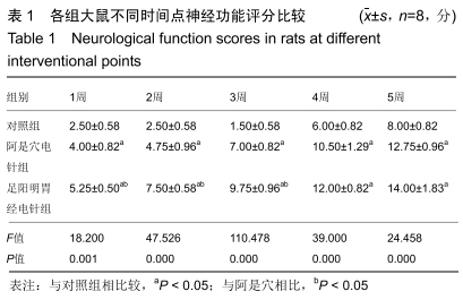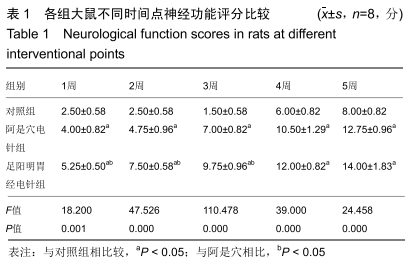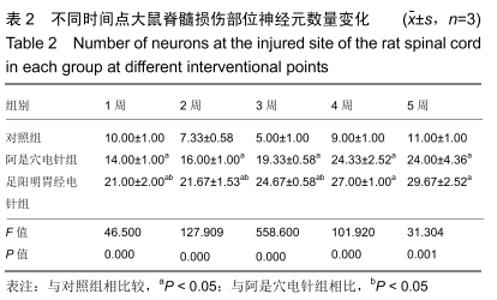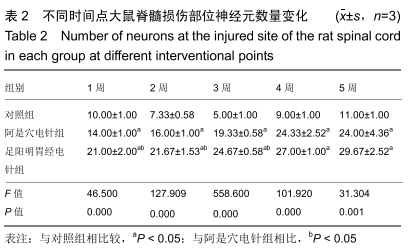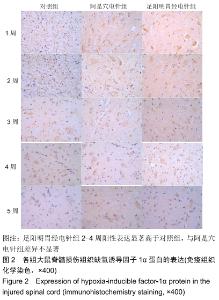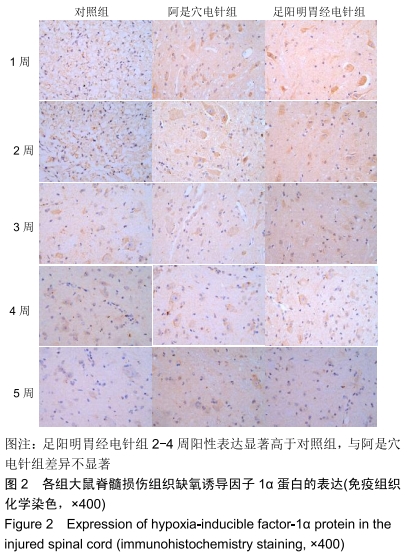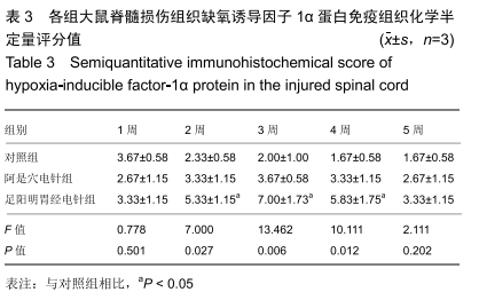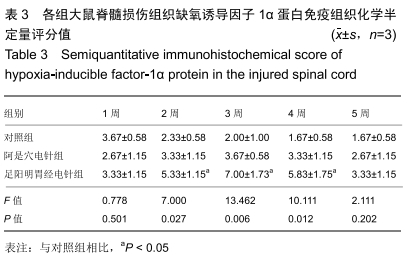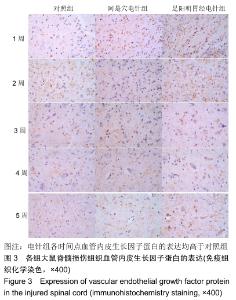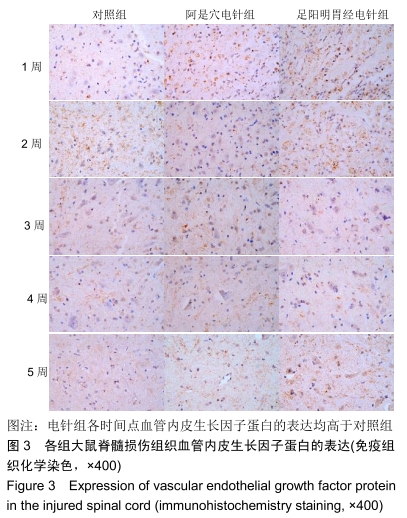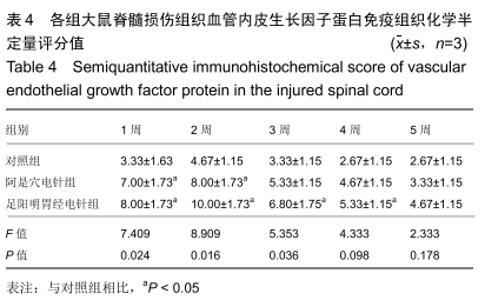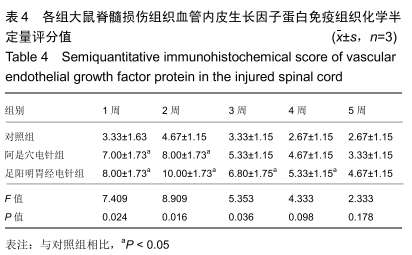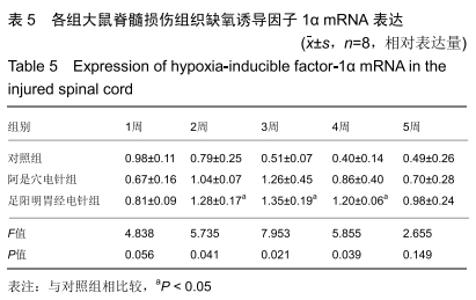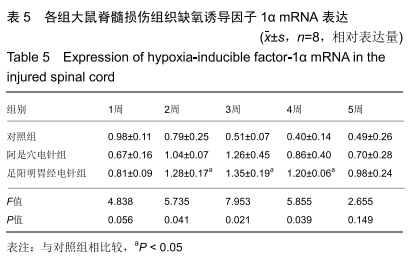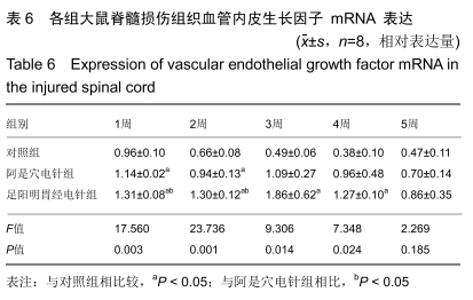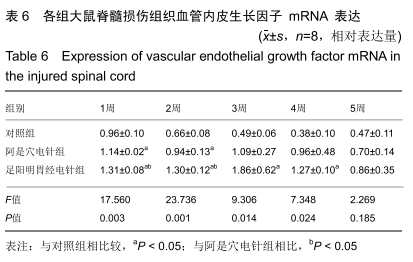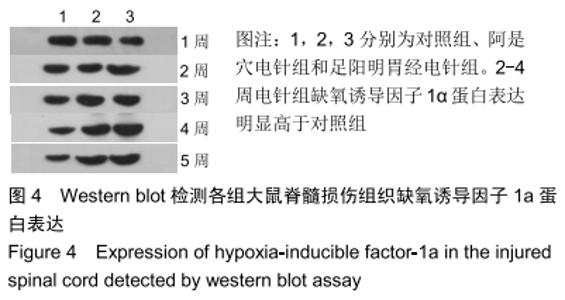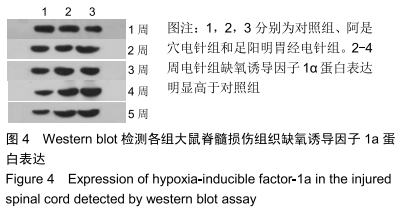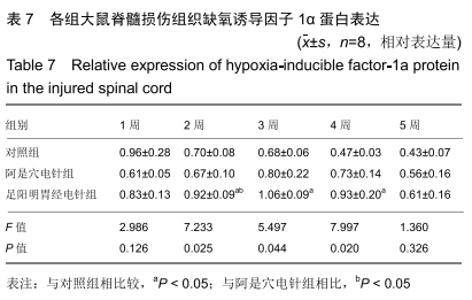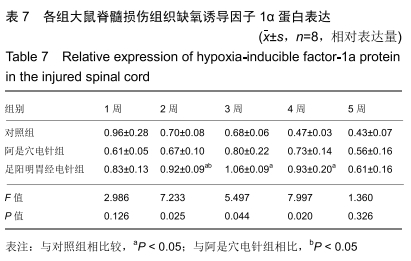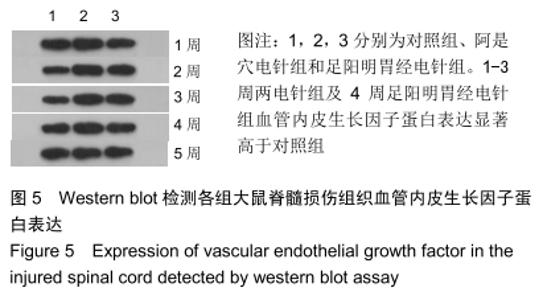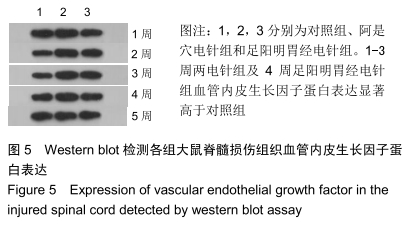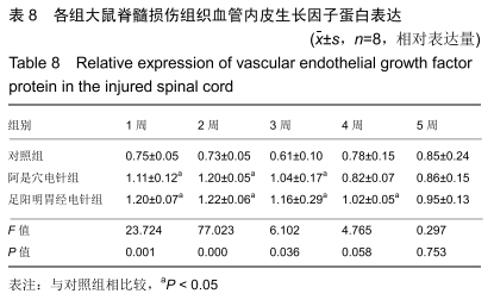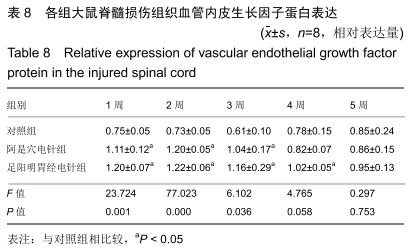Chinese Journal of Tissue Engineering Research ›› 2020, Vol. 24 ›› Issue (11): 1701-1707.doi: 10.3969/j.issn.2095-4344.2506
Previous Articles Next Articles
Effect of electroacupuncture intervention on expression of hypoxia-inducible factor-1 alpha and vascular endothelial growth factor in injured segments of rats with spinal cord injury
Zhang Hongsheng1, Wei Weibing2, Zhou Binbin3, Cui Junwu3, Li Zhenxing3, Wang Yongqing4
- 1Ruikang Hospital, Guangxi University of Chinese Medicine, Nanning 530000, Guangxi Zhuang Autonomous Region, China; 2Liuzhou Hospital of Traditional Chinese Medicine; 3First Affiliated Hospital, Guangxi University of Chinese Medicine, Nanning 530022, Guangxi Zhuang Autonomous Region, China; 4Fourth Central Hospital of Tianjin, Tianjin 300140, China
-
Received:2019-07-23Revised:2019-07-26Accepted:2019-08-23Online:2020-04-18Published:2020-02-27 -
Contact:Zhou Binbin, Chief physician, Professor, First Affiliated Hospital, Guangxi University of Chinese Medicine, Nanning 530022, Guangxi Zhuang Autonomous Region, China -
About author:Zhang Hongsheng, Master, Attending physician, Ruikang Hospital, Guangxi University of Chinese Medicine, Nanning 530000, Guangxi Zhuang Autonomous Region, China Wei Weibing, Master, Physician, Liuzhou Hospital of Traditional Chinese Medicine, Liuzhou 545001, Guangxi Zhuang Autonomous Region, China Zhang Hongsheng and Wei Weibing contributed equally to this work. -
Supported by:the National Natural Science Foundation of China, No. 81660814
CLC Number:
Cite this article
Zhang Hongsheng, Wei Weibing, Zhou Binbin, Cui Junwu, Li Zhenxing, Wang Yongqing. Effect of electroacupuncture intervention on expression of hypoxia-inducible factor-1 alpha and vascular endothelial growth factor in injured segments of rats with spinal cord injury [J]. Chinese Journal of Tissue Engineering Research, 2020, 24(11): 1701-1707.
share this article
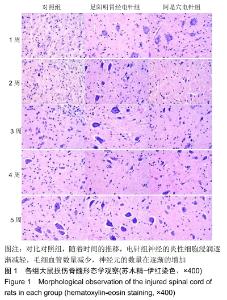
2.3 病理组织检查结果 苏木精-伊红染色见图1。对照组1周时脊髓结构极度紊乱,神经元消失,部分髓鞘脱失,中度炎细胞浸润;2周后脊髓结构逐渐修复部分神经元逐渐出现直至第5周脊髓结构轻微紊乱,神经元数量明显增多,无髓鞘脱失,偶有炎细胞浸润,无明显出血。阿是穴电针组及足阳明胃经电针组1周灰质区中度炎细胞浸润,毛细血管数量增多,有轻微出血,有少量脂肪滴;与1周相比,2周时炎细胞浸润减轻,毛细血管数量减少,无出血,结构仍显紊乱;与2周相比,3周时炎细胞浸润无明显变化,无出血,结构稍微紊乱;与3周相比,4周轻度炎性细胞浸润,无出血,神经元数量增多,结构略显紊乱;5周轻度炎细胞浸润,无出血,神经元数量增多。 "

| [1] TOMASCHEK R, GEMPERLI A, RUPP R, et al.A systematic review of outcome measures in initial rehabilitation of individuals with newly acquired spinal cord injury: providing evidence for clinical practice guidelines.Eur J Phys Rehabil Med. 2019;55(5): 605-617. [2] MCDAID D, PARK AL, GALL A, et al.Understanding and modelling the economic impact of spinal cord injuries in the United Kingdom. Spinal Cord. 2019;57(9):778-788. [3] CHAN BC, CADARETTE SM, WODCHIS WP, et al.The lifetime cost of spinal cord injury in Ontario, Canada: A population-based study from the perspective of the public health care payer.J Spinal Cord Med.2019;42(2):184-193. [4] ANDO T, SATO S, TOYOOKA T, et al.Photomechanical wave- driven delivery of siRNAs targeting intermediate filament proteins promotes functional recovery after spinal cord injury in rats.PLoS One.2012;7(12):e51744. [5] CENTENARO LA, DA CUNHA JAEGER M, ILHA J, et al. Implications of olfactory lamina propria transplantation on hyperreflexia and myelinated fiber regeneration in rats with complete spinal cord transection.Neurochem Res.2013,38(2):371-381. [6] TAN AM, CHAKRABARTY S, KIMURA H, et al.Selective corticospinal tract injury in the rat induces primary afferent fiber sprouting in the spinal cord and hyperreflexia.J Neurosci.2012;32(37):12896-12908. [7] LONG HQ, LI GS, CHENG X, et al.Role of hypoxia-induced VEGF in blood-spinal cord barrier disruption in chronic spinal cord injury. Chin J Traumatol.2015;18(5):293-235. [8] YU S, YAO S, WEN Y, et al.Angiogenic microspheres promote neural regeneration and motor function recovery after spinal cord injury in rats.Sci Rep.2016;6:33428. [9] WANG H, WANG Y, LI D, et al.VEGF inhibits the inflammation in spinal cord injury through activation of autophagy.Biochem Biophys Res Commun.2015;464(2):453-458. [10] LI P, LIU J, CHEN X, et al.Relationship between the distribution of spinal nerve posterior ramus and locations of acupoint in low back. Zhongguo Zhen Jiu.2017;37(6):625-628. [11] RAHIMI-MOVAGHAR V, JAZAYERI SB.When do we start Basso, Beattie, and Bresnahan assessment after experimental spinal cord injury? Acta Med Iran.2013;51(8):5183. [12] SOSLOW RA, DANNENBERG AJ, RUSH D, et al. Cox-2 is expressed in human pulmonary, colonic, and mammary tumors. Cancer.2000;89:2637-2645. [13] GU Y, CHENG X, HUANG X, et al.Conditional ablation of reactive astrocytes to dissect their roles in spinal cord injury and repair. Brain Behav Immun. 2019;80:394-405. [14] CHEN H, LI J, LIANG S, et al.Effect of hypoxia-inducible factor-1/vascular endothelial growth factor signaling pathway on spinal cord injury in rats.Exp Ther Med.2017;13(3):861-866. [15] WAHMAN K, NILSSON WIKMAR L, CHLAIDZE G, et al. Secondary medical complications after traumatic spinal cord injury in Stockholm, Sweden: Towards developing prevention strategies.J Rehabil Med.2019;51(7):513-517. [16] GUPTA N.Lack of adequate care post spinal cord injury - a case report.Spinal Cord Ser Cases.2019;5:22 [17] STAMPAS A, TANSEY KE.Spinal cord injury medicine and rehabilitation.Semin Neurol.2014;34(5):524-533. [18] GUI L, LIU B, LV G. Hypoxia induces autophagy in cardiomyocytes via a hypoxia-inducible factor 1-dependent mechanism.Exp Ther Med.2016;11(6):2233-2239. [19] BASAGIANNIS D, ZOGRAFOU S, MURPHY C,et al.VEGF induces signalling and angiogenesis by directing VEGFR2 internalisation through macropinocytosis.J Cell Sci. 2016; 129(21):4091-4104. [20] VASTA S, DI MARTINO A, ZAMPOGNA B, et al.Role of VEGF, Nitric Oxide, and Sympathetic Neurotransmitters in the Pathogenesis of Tendinopathy: A Review of the Current Evidences.Front Aging Neurosci.2016;8:186. [21] D'ALESSIO A, PROIETTI G, LAMA G, et al.Analysis of angiogenesis related factors in glioblastoma, peritumoral tissue and their derived cancer stem cells.Oncotarget. 2016;7(48):78541-78556. [22] LIU F, ZOU Y, LIU S, et al.Electro-acupuncture treatment improves neurological function associated with downregulation of PDGF and inhibition of astrogliosis in rats with spinal cord transection.J Mol Neurosci.2013;51(2):629-635. [23] YANG JH, LV JG, WANG H, et al.Electroacupuncture promotes the recovery of motor neuron function in the anterior horn of the injured spinal cord.Neural Regen Res. 2015;10(12):2033-2039. |
| [1] | Min Youjiang, Yao Haihua, Sun Jie, Zhou Xuan, Yu Hang, Sun Qianpu, Hong Ensi. Effect of “three-tong acupuncture” on brain function of patients with spinal cord injury based on magnetic resonance technology [J]. Chinese Journal of Tissue Engineering Research, 2021, 25(在线): 1-8. |
| [2] | Lun Zhigang, Jin Jing, Wang Tianyan, Li Aimin. Effect of peroxiredoxin 6 on proliferation and differentiation of bone marrow mesenchymal stem cells into neural lineage in vitro [J]. Chinese Journal of Tissue Engineering Research, 2021, 25(7): 1014-1018. |
| [3] | Li Yan, Wang Pei, Deng Donghuan, Yan Wei, Li Lei, Jiang Hongjiang. Electroacupuncture for pain control after total knee arthroplasty: a meta-analysis [J]. Chinese Journal of Tissue Engineering Research, 2021, 25(6): 957-963. |
| [4] | Chen Junyi, Wang Ning, Peng Chengfei, Zhu Lunjing, Duan Jiangtao, Wang Ye, Bei Chaoyong. Decalcified bone matrix and lentivirus-mediated silencing of P75 neurotrophin receptor transfected bone marrow mesenchymal stem cells to construct tissue-engineered bone [J]. Chinese Journal of Tissue Engineering Research, 2021, 25(4): 510-515. |
| [5] | Hao Xiaona, Zhang Yingjie, Li Yuyun, Xu Tao. Bone marrow mesenchymal stem cells overexpressing prolyl oligopeptidase on the repair of liver fibrosis in rat models [J]. Chinese Journal of Tissue Engineering Research, 2021, 25(25): 3988-3993. |
| [6] | Chen Yutong, Li Chenchen, Liu Yang, Zheng Yaqin, Yang Xihua, An Meiwen. Establishment of an acute radioactive skin injury model in Wistar rats [J]. Chinese Journal of Tissue Engineering Research, 2021, 25(2): 237-241. |
| [7] | Huang Zhusong, Lin Yu, Chen Xiang, Lan Jinfu, Guan Yong, Gao Xi. Alcohol extract of Morinda officinalis improves lipid metabolism and bone metabolism in ovariectomized obese rats [J]. Chinese Journal of Tissue Engineering Research, 2021, 25(2): 205-210. |
| [8] | Zhang Shengmin, Cao Changhong, Liu Chao. Adipose-derived stem cells integrated with concentrated growth factors prevent bisphosphonate-related osteonecrosis of the jaws in SD rats [J]. Chinese Journal of Tissue Engineering Research, 2021, 25(19): 2982-2987. |
| [9] | Dai Yaling, Chen Lewen, He Xiaojun, Lin Huawei, Jia Weiwei, Chen Lidian, Tao Jing, Liu Weilin. Construction of miR-146b overexpression lentiviral vector and the effect on the proliferation of hippocampal neural stem cells [J]. Chinese Journal of Tissue Engineering Research, 2021, 25(19): 3024-3030. |
| [10] | Wang Donghui, Wu Xin, Sun Ningning, Zhang Han, Gao Jianfeng. Electroacupuncture intervention on the expression of synaptic plasticity-related proteins in the hippocampi of mice with radiation-induced brain injury [J]. Chinese Journal of Tissue Engineering Research, 2021, 25(14): 2205-2210. |
| [11] | Jiang Tao, Wu Shuo, Li Zhiqiang, Shou Xi, Mayire·Nuermaimaiti, Ma Chuang, Wei Qin. Platelet-derived growth factor BB promotes the proliferation of bone marrow mesenchymal stem cells of Sprague-Dawley rats [J]. Chinese Journal of Tissue Engineering Research, 2021, 25(13): 1976-1981. |
| [12] | Zang Jing, Luan Zuo, Wang Qian, Yang Yinxiang, Wang Zhaoyan, Wu Youjia, Guo Aisong. Two kinds of stem cell nasal transplantation for treating white matter injury in premature rat infants [J]. Chinese Journal of Tissue Engineering Research, 2021, 25(1): 101-107. |
| [13] | Fei Jing, Zheng Hongdi, Yu Liya, Li Leiji. Involvement of GDNF/PI3K/AKT pathway in promoting facial nerve regeneration using electroacupuncture in a rabbit model of facial nerve crush injury [J]. Chinese Journal of Tissue Engineering Research, 2020, 24(7): 1094-1100. |
| [14] | Wang Jing, Lu Changfeng, Peng Jiang, Zhu Chen, Xu Wenjing, Cheng Xiaoqing, Fang Jie, Zhu Yaqiong, Zhao Yanxu, Jiang Wen, Xu Hongguang, Wang Yu. Establishment and evaluation of traumatic neuroma model [J]. Chinese Journal of Tissue Engineering Research, 2020, 24(5): 716-719. |
| [15] | Wei Weibing, Zhou Binbin, Zhang Hongsheng, Yang Yu, Cui Junwu, Li Zhenxing. Effect of Electroacupuncture at Zusanli and Futu acupoints on expression of apoptosis factor Caspase-3 in spinal cord injury rats [J]. Chinese Journal of Tissue Engineering Research, 2020, 24(32): 5151-5157. |
| Viewed | ||||||
|
Full text |
|
|||||
|
Abstract |
|
|||||
